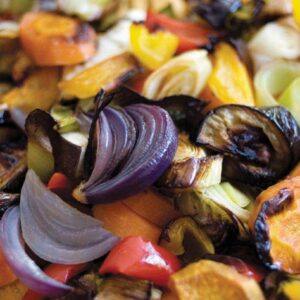
Advice for parents of toddlers on how to develop a love of healthy food in your child.
Every parent has moments where giving in to your toddler’s food demands is easier than taking a stand and making them eat healthy food.
Sometimes we have to do it for our emotional health and sometimes for social reasons (to avoid World War III at the café…).
But making the effort to teach our kids healthy eating habits is one of the best gifts we can give them for their long-term health.
Healthy food gives kids a head start in life
Instinctively we know that the food we feed our children has a huge effect on their growth, behaviour and health. And science supports our instinct:
- Babies who are breast-fed have less risk of developing allergies
- Toddlers who are deficient in iron can have impaired brain and intellectual development, which is permanent and irreversible
- Children who have a lower saturated fat intake in childhood are less likely to develop insulin resistance – a key predictor for diabetes and heart disease
- Babies who are underweight in their first two years of life and who then gain weight rapidly have a greater risk of insulin resistance and heart disease in adulthood
- Around two out of every three obese children will become obese adults, especially children who are still obese after the age of 10.
How our food habits are formed
The food we grow up with is often the food we prefer as adults. If you think about the foods you like to eat; many of these may be foods you ate as a child.
For example, my mother went through a health phase when we were kids and decided we didn’t need salt but we did need wheat germ (a great source of vitamins B and E). So we all had wheat germ sprinkled on our salt-free porridge every morning.
What started as taste bud torture soon became normal, and we all still eat porridge that way!
Food routines can also carry over into adulthood. If you grew up in a family where you all sat around the television enjoying fish and chips while watching the rugby, chances are that as an adult you will not sit down to watch the rugby with a bowl of carrot sticks.
Stages in development
Young children have a natural preference for sweet foods, which throughout history has attracted them to energy-rich foods to help them grow, and kept them away from poisonous foods which tend to taste bitter. It’s why they choose grapes over olives and carrots over broccoli.
One of our roles is to gradually introduce our children to as wide a range of foods and flavours as possible. The second six months of life is a constant adventure in new flavours, and by one year of age a child should be eating a basic version of the family’s meals – meat, fish or chicken, vegetables, fruit, bread, cereals, rice, pasta and dairy foods.
In fact a one year old may eat as much as, or even more than a five year old. This is a stage when we can feel that we have got it together as far as feeding goes.
Then around the two-year mark their growth rate slows and the ‘four-Weet-Bix-a-morning’ baby turns into a ‘bite-of-toast’ toddler. Toddlers grow in spurts and their appetite reflects this with days of eating lots and days or weeks of eating very little.
It’s common to start worrying about whether they are getting enough for their needs. But children are naturally designed to eat exactly the amount they need. They regulate the quantity; it’s our job to choose the quality. Children don’t need to clear the plate. In this age of excess food we need children to maintain their natural ability to stop when feeling full. Forcing them to finish everything on the plate will eventually override this important mechanism.
When my toddler starting refusing meat, I fell into frantic visions of his brain atrophying from lack of iron. I had to keep reminding myself that it was only a brief stage in his development.
Keeping this in mind helps you get them through the toddler years without food hangups.
Hangups usually develop when over-concerned parents get into food fights with their toddler, start using bribery to get them to eat so-called ‘good’ food, and unwittingly help their kids discover that the word “no” can cause mummy and daddy to act in very entertaining ways!
The power of “no”
We’ve all prepared meals only to have them refused. Our responses can vary from acceptance: “Well, what would you like instead?” (you’re not a restaurant) to bribery: “If you eat this, you can have some ice cream” (bingo – this is how to get the sweet stuff!).
Toddlers soon learn if refusing a meal will get them what they really want. It really is a battle of control and we, the parents, need to win.
Put the meal in the fridge and re-heat it when your child gets hungry or at the next meal-time. If it means going to bed with no dinner one night, try to suppress those feelings of sympathy and guilt, and think about the long-term goal. No child ever faded away from missing a meal.
How to encourage healthy habits
Get kids involved
Life is a great adventure for young children and food can be part of it.
- Let them pick herbs or vegetables out of the garden, if you have one.
- Point out interesting fruit and vegetables in the supermarket and let them choose one to take home.
- Let them help you pat out the scones or measure out ingredients for baking. Be prepared for some mess and the odd spill. Fruit smoothie on your clothes and egg shells in the cake mix is worth it if the children grow up viewing food as fun.
Make your own takeaways
Homemade takeaways are healthier, cheaper and fun. Try these:
- Fish and chips: Pan-fried fish with oven baked chips.
- Burgers: Make beef patties with lean mince and grated vegetables. Place on a burger bun and children can choose from grated carrot, tomato, lettuce, cheese, beetroot and tomato sauce to top off.
- Pizza: Make your favourite base or for toddlers use half a muffin as the base.
- Burrito: Spread a warmed tortilla with hummus, light sour cream or capsicum pesto. Roll up with your child’s choice of thinly sliced cooked chicken, avocado, tomato, grated cheese, grated carrot and shredded lettuce.
Meal times
Even if your busy schedule doesn’t allow for eating together as a family every night, try to have at least one night a week where you all sit down together.
This is where children learn the social aspects of food: how to set the table, how to use cutlery, table manners, and how to chat over a meal rather than grunting a few syllables while mesmerised by the television. They see how you eat and what you eat.
It’s also gives you a chance to give children more control over what they eat: place the food on the table buffet-style and let them help themselves. They may be tempted to try the hated courgette when they see everyone else enjoying it.
Eating out
Choose interesting foods from the menu and ask for child sizes if possible. Kids don’t have to have chips every time they are at a restaurant.
Your children might like pasta dishes, risotto, fried rice, noodles, eggs or breads and dips.
Or take them to a restaurant that serves tapas; small plates of bite sized food. You can order a whole range of food and they can try little bits of lots of new flavours.
Building strong bones
Calcium is essential for young growing bodies and dairy foods (milk, yoghurt and cheese) are the best source of this bone-building nutrient. The Ministry of Health recommends that children under the age of five drink 500ml (about two cups) of milk each day. This should be full-fat milk up until the age of two.
If your child does not like to drink large glasses of milk, try these calcium-rich food ideas:
- Sprinkle cheese on food
- Spread a thin layer of vegemite on old bread, slice into fingers, sprinkle with cheese and bake until crisp for crunchy crackers
- Yoghurt
- Custard
- Milk puddings
- Rice pudding
- Smoothies and milkshakes
- Make porridge with milk instead of water
- Add milk to soups, mashed potato, mince
- For non-dairy calcium foods try sardines, nuts, eggs, whole grains and legumes
Do toddlers need low-fat?
No. A toddler’s body needs fat to grow and develop. It provides the fat-soluble vitamins A, D and E. It also provides essential fats that the body can’t make including one called DHA, which is essential for a baby’s brain and retinal visual function.
After age two, children can drink reduced-fat milk so long as they are eating a good variety of food. Fatty build-up in the arteries does start in childhood so if you are concerned about your child’s fat intake, first concentrate on limiting fatty takeaways and fried foods, rather than reducing milk. And encourage healthy fats from fish, vegetable oils, nuts, peanut butter (choose no added salt or sugar), seeds, grainy bread and whole grain cereals.
Can my child have too much fibre?
Fibre helps keep children’s bowels regular, prevents over-eating leading to obesity, and keeps cholesterol and blood sugar levels normal. The best way to ensure enough fibre is to give your children a wide variety of fruit, vegetables and whole grains – not too much though, or they will be so full they won’t be able to eat enough food for their rapid growth needs.
Toddlers need about two pieces of fruit and a cup of vegetables each day, as well as about four serves of breads and cereals. The sample menu below shows how to fit this into a child’s eating pattern.
Water
Water is the best fluid for both adults and children. Our body is 70% water and if we don’t top it up each day we can feel tired, and suffer headaches, dry skin and constipation. There is no exact amount recommended for children but it’s a good idea to get children into the habit of drinking water regularly. Teach children to drink even when not thirsty as by the time they feel thirsty they are well on the way to dehydration. A well-hydrated child will have pale urine.
Encourage children with small, frequent drinks of water. Keep cordial and fruit juice for occasional drinks and serve them diluted with water. Always take a water bottle when going out, order water when eating out and serve water with snacks and meals.
Sample menu for a toddler
Breakfast
- 1/2 cup porridge or 1 Weet-bix with milk
- 1 piece toast with spread and honey
- drink of diluted juice or a few slices of orange or kiwifruit
Morning tea
- 1 small banana muffin or 1 slice Carrot and nut cake
Lunch
- egg sandwich on wholemeal bread
- 1/2 apple
- drink of water
Afternoon tea
- peanut butter on wholemeal bread or crackers
- 3 seedless grapes
- drink of water
Dinner
- lean mince with 2-3 vegetables sprinkled with cheese
- 1/2 cup rice or pasta
- 1/2 cup milk pudding or 1/2 small pottle yoghurt
www.healthyfood.com










